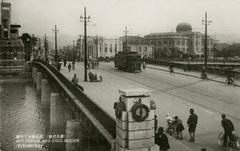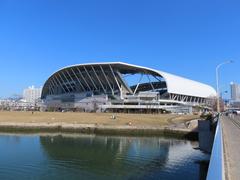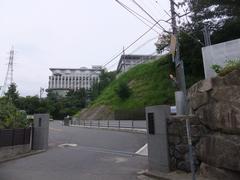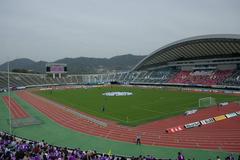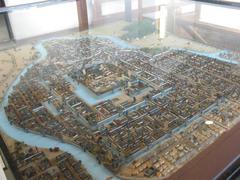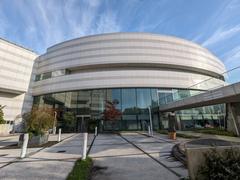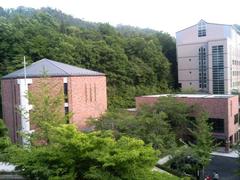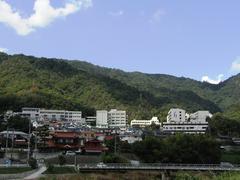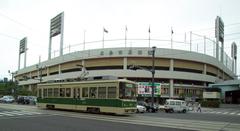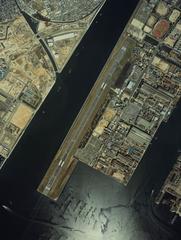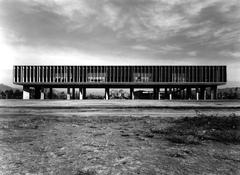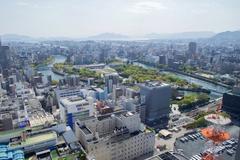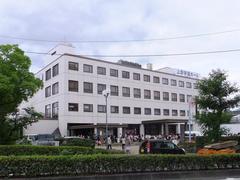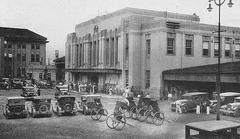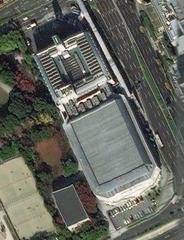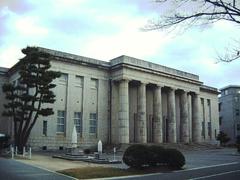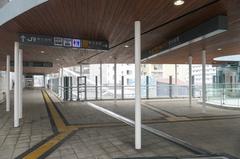
Kenchō-Mae Station Hiroshima: Visiting Hours, Tickets, and Guide to Nearby Historical Sites
Date: 04/07/2025
Introduction
Kenchō-Mae Station is an essential gateway in Hiroshima, Japan, strategically located in the city’s governmental and commercial heart. Serving as a primary transit node on the Astram Line and Hiroden tram network, the station provides seamless access to Hiroshima’s profound historical legacy, thriving urban life, and renowned cultural landmarks. As a modern transit hub, Kenchō-Mae reflects Hiroshima’s transformation—from its origins as a castle town through postwar reconstruction, to its contemporary status as a symbol of peace and resilience (city.hiroshima.lg.jp, urbanrail.net).
This guide delivers comprehensive information on visiting hours, ticketing, accessibility, and architectural features of Kenchō-Mae Station. It also highlights must-see nearby attractions, including solemn memorials, vibrant shopping districts, tranquil gardens, and Hiroshima’s celebrated food culture. Whether you are a history enthusiast or a traveler eager for modern urban experiences, this resource ensures a smooth, enriching journey through Hiroshima.
Contents
- Historical Development of Kenchō-Mae Station
- Visiting Hours and Ticket Information
- Accessibility and Visitor Services
- Architectural and Infrastructural Features
- Socioeconomic and Urban Significance
- Nearby Attractions and Photographic Spots
- Visitor Tips and Essential Information
- Frequently Asked Questions (FAQ)
- Hiroshima Peace Memorial: Visiting Guide
- Summary and Practical Resources
- Sources
Historical Development of Kenchō-Mae Station
Early Urbanization and Transportation
The evolution of Hiroshima from a castle town to a modern metropolis is closely connected to the development of its transportation systems. The introduction of electric streetcars in 1912 by the Hiroshima Electric Railway (Hiroden) marked a turning point, replacing horse-drawn carriages and establishing a foundation for Japan’s largest tram network (city.hiroshima.lg.jp, urbanrail.net). The Kenchō-Mae area, meaning “in front of the Prefectural Office,” quickly became a strategic urban node due to its proximity to key administrative, commercial, and cultural institutions.
Postwar Reconstruction and Urban Renewal
After the devastation of 1945, Hiroshima undertook an ambitious reconstruction guided by the Hiroshima Peace Memorial City Construction Law (1949). The central districts, including Kenchō-Mae, became focal points for redevelopment, integrating modern infrastructure, efficient public transit, and green spaces. The area’s designation as a Specified Area for Urban Renewal in the late 20th century spurred significant private and public investment, resulting in new commercial and civic landmarks (city.hiroshima.lg.jp).
Astram Line and Modernization
The 1994 opening of the Astram Line, a state-of-the-art rubber-tyred monorail system, marked a pivotal moment in Hiroshima’s transit modernization. Kenchō-Mae Station, an underground stop on the Astram Line, was engineered for smooth multimodal transfers, connecting with the extensive Hiroden tram network and city buses. The station’s location beneath the governmental and commercial center optimizes access to major attractions, shopping districts, and civic spaces (urbanrail.net, triptojapan.com).
Visiting Hours and Ticket Information
- Station Hours: Open daily from approximately 6:00 AM to midnight, aligning with Astram Line and Hiroden tram schedules. The associated Shareo underground shopping arcade operates typically from 10:00 AM to 8:00 PM.
- Ticketing: Tickets for the Astram Line and Hiroden trams are available at station vending machines. Fares start at about 200 yen and vary by distance. IC cards such as Suica, Pasmo, and ICOCA are accepted for convenient, cashless travel (triptojapan.com).
- Tourist Passes: Consider the Hiroshima One-day Card for unlimited tram and bus rides—ideal for sightseeing over a single day.
- Guided Tours: While Kenchō-Mae Station itself does not offer tours, information on local guided experiences is available at nearby tourist centers.
Accessibility and Visitor Services
Kenchō-Mae Station is fully equipped for universal accessibility:
- Elevators and escalators
- Tactile paving for the visually impaired
- Barrier-free restrooms
- Bilingual signage (Japanese and English)
- Station staff available for assistance
These features ensure a comfortable experience for travelers of all mobility levels.
Architectural and Infrastructural Features
The station boasts modern Japanese transit architecture:
- Underground platforms with platform screen doors for safety
- Seamless transfers between Astram Line, Hiroden trams, and buses
- Connected Shareo underground shopping mall for climate-controlled shopping and dining
- Direct access to the Hiroshima Bus Center integrated with the Sogo Department Store
Socioeconomic and Urban Significance
Kenchō-Mae anchors a vibrant district featuring:
- Hiroshima Prefectural Government Office
- Hiroshima Museum of Art
- Sogo Department Store
- Hiroshima Bus Center
The development of the Shareo underground arcade (2001) transformed the area into a bustling commercial and social hub (city.hiroshima.lg.jp). Its centrality supports over a million annual visitors to nearby historical sites, reinforcing Hiroshima’s role as a city of peace, memory, and modernization (timetomosey.com).
Nearby Attractions and Photographic Spots
Top Historical and Cultural Sites
- Hiroshima Peace Memorial Park and Museum: A UNESCO World Heritage Site commemorating the atomic bombing, featuring the iconic Atomic Bomb Dome, the Peace Memorial Museum, Cenotaph, and Children’s Peace Monument.
- Hiroshima Castle: Reconstructed after WWII, this historic site features samurai exhibits, moats, and seasonal cherry blossoms.
- Shukkei-en Garden: Edo-period garden renowned for seasonal scenery and tranquility.
- Hondori Shopping Street: Lively arcade for shopping, dining, and local culture.
Art, Science, and Food
- Hiroshima Museum of Art: Collection of European and Japanese modern art.
- Okonomimura: Multi-story food complex dedicated to Hiroshima-style okonomiyaki.
- Orizuru Tower: Observation deck with panoramic city views.
- Hiroshima Children’s Museum: Interactive science and educational exhibits.
- Mazda Museum: Guided tours of Mazda’s automotive innovation (advance reservation required).
Temples and Green Spaces
- Mitaki-dera Temple: A tranquil temple complex nestled in forested hills.
- Central Park (Chūō Kōen): Expansive green space ideal for relaxation and seasonal events.
Visitor Tips and Essential Information
- Navigation: Use apps or station maps for efficient transfers; signage in English and Japanese.
- IC Cards: Suica, Pasmo, and ICOCA accepted for trams, buses, and most shops.
- Weather: Shareo underground mall offers shelter during rain or heat.
- Best Seasons: Visit in spring (cherry blossoms) or autumn (maple leaves) for scenic beauty.
- Dining: Try Hiroshima’s specialties at Okonomimura or local izakayas.
- Shopping: Explore Sogo department store, Hondori Shopping Street, and underground arcades.
Frequently Asked Questions (FAQ)
Q: What are Kenchō-Mae Station’s opening hours?
A: Approximately 6:00 AM to midnight daily.
Q: How do I buy tickets?
A: Use station vending machines or IC cards (Suica, Pasmo, ICOCA).
Q: Is the station accessible for people with disabilities?
A: Yes, with elevators, tactile paving, barrier-free restrooms, and staff assistance.
Q: Which historical sites are within walking distance?
A: Hiroshima Peace Memorial Park, Hiroshima Castle, Shukkei-en Garden, Hondori Shopping Street, and Okonomimura.
Q: Are guided tours available?
A: Many nearby attractions offer tours; inquire at local tourist centers.
Hiroshima Peace Memorial: Visiting Guide
Overview
The Hiroshima Peace Memorial (Atomic Bomb Dome) stands as a UNESCO World Heritage Site and global symbol of peace. The preserved ruins and surrounding park commemorate the atomic bombing of August 6, 1945, and the city’s commitment to peace and nuclear disarmament.
Visiting Hours and Tickets
- Park: Open 24 hours, year-round.
- Peace Memorial Museum: 8:30 AM–6:00 PM (extended hours in peak seasons; closed Dec 30–31).
- Admission: Park and Dome are free. Museum: ¥200 adults, ¥100 students, free for juniors.
- Tickets: Buy at the museum or online (hpmmuseum.jp).
Access
- Nearest Station: Kenchō-Mae Station (Astram Line, Hiroden Lines 1, 2, 6); 5-minute walk to the park.
- Other Transit: Hondori Station (Astram Line) and city buses.
Facilities and Accessibility
- Wheelchair accessible with ramps and elevators.
- Multilingual signage.
- Restrooms, lockers, gift shop, and cafes available.
Highlights
- Atomic Bomb Dome (viewable from outside)
- Peace Memorial Museum
- Children’s Peace Monument
- Cenotaph for the A-Bomb Victims
Special Events
- Annual Peace Memorial Ceremony (August 6)
- Guided tours and audio guides available in multiple languages
Practical Tips
- Visit early to avoid crowds.
- Allocate 2–3 hours for the museum and park.
- Respect the solemn atmosphere; photography outdoors is permitted.
Summary of Key Visitor Information and Tips for Kenchō-Mae Station
Kenchō-Mae Station exemplifies Hiroshima’s balance between honoring history and embracing the future. Its central location, modern amenities, and extensive transit connections make it the ideal starting point for exploring the city’s cultural and historical treasures. With accessible facilities, clear signage, and proximity to landmarks like the Hiroshima Peace Memorial Park and Castle, visitors can enjoy a seamless and enriching experience (city.hiroshima.lg.jp, urbanrail.net, hpmmuseum.jp, triptojapan.com).
For up-to-date transit information, event schedules, and personalized tips, download the Audiala app and refer to official tourism resources.
Sources
- Kenchō-Mae Station in Hiroshima: History, Visiting Hours, Tickets, and Nearby Attractions, 2025, Hiroshima City Official Website (city.hiroshima.lg.jp)
- Hiroshima Public Transit and Tram Network Overview, 2025, UrbanRail (urbanrail.net)
- Getting Around Hiroshima: Transportation Tips and Tricks for Tourists, 2025, Trip to Japan (triptojapan.com)
- Walk from Hiroshima Station to Hiroshima Peace Memorial Park, 2025, Time to Mosey (timetomosey.com)
- Hiroshima Peace Memorial Museum Official Website, 2025 (hpmmuseum.jp)
- Visiting Hiroshima Peace Memorial: Hours, Tickets, and Historical Significance, 2025


